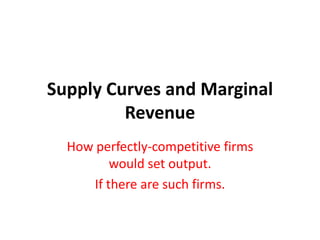
Class 13 supply curves and marginal revenue 100410
- 1. Supply Curves and Marginal Revenue How perfectly-competitive firms would set output. If there are such firms.
- 2. The BIG ideas • Perfectly competitive firms produce until MU=MC. • This is irrelevant because there are no perfectly competitive firms. Monopolies produce where MC=Marginal Revenue. • At MU=MC, firms lose money on some output because are not accounting for fixed inputs. • Rational firms establish monopolies to raise prices, reducing production until MC=MR.
- 3. Orthodox bottom line: Supply Curves slope up and firms produce where MU=MC The punch line and the real story: It ain’t necessarily so. Price Monopoly P and Q Perfect Competitive P and Q Output
- 4. Perfectly competitive firms ignore their effect on market prices and think only of marginal costs
- 5. Why do marginal costs rise? 1. Because of diminishing marginal productivity. 2. Because variable inputs have less and less with which to work. 3. Because the MPL declines with additional workers. 4. All of the above.
- 6. Perfectly competitive firms produce if Price > or = Marginal Cost they think they profit if produce at a marginal cost less than the selling price.
- 7. At the PC Equilibrium: 1. Independence: market supply is the sum of each individual firm’s output. Add it up. 2. Price leads firms to produce what consumers want at that price. 3. More output comes with a higher price (moving up the MC or PC Supply Curve). 4. Less output at lower price if consumer demand declines (moving down the MC or PC Supply Curve).
- 8. Output increases with higher prices along the Supply Curve because at higher prices firms can profit at higher MC
- 9. Firms profit on inframarginal output Don’t produce!
- 10. In perfect competition, excessive profits attracts new entrants to drive down prices and profits
- 11. Perfect Competition is Impossible 1. Perfect competitors ignore “sunk costs” 2. They ignore the effect that increasing production and sales has on the market price. Perfectly competitive firms go bankrupt.
- 12. Compare Marginal Costs with Average Total Costs MC and Supply Curve: Perfect Competition Loss $8.00 between ATC P $6.00 and r Price i $4.00 c e $2.00 $0.00 1 2 3 4 5 6 7 8 9 10 Quantity MC Demand Pri ce Average total costs
- 13. To stay in business, firms must cover marginal costs and fixed costs They cannot do this if they are perfectly competitive and sell at MC! Our capitalist economy can only function if firms are monopolies. Right again
- 14. How would you price airline tickets? How much do you think it costs an airline to fly one more passenger from Boston to Paris? 1.Marginal cost (about $50) 2.Average cost (about $330) 3.$500 (about the price of a ticket)
- 16. Perfectly competitive firms are myopic. And dumb. They ignore the effect that Firms sell their increased increasing output has output by lowering on the market price prices. Duh. So the extra revenue they get from selling more must be discounted by the lower prices they now charge everyone else.
- 17. Algebra MR= P – Q * Δ P Marginal revenue is the price you get for the new sale minus the discount you give on all your earlier sales. Isn’t math fun?
- 18. Why MR < Price Sales Demand TR Discount MR $30.00 1 $25.00 $25.00 $-00 $25.00 $25.00 2 $23.75 $47.50 $(1.25) $22.50 3 $22.56 $67.69 $(2.38) $20.19 $20.00 4 $21.43 $85.74 $(3.38) $18.05 $15.00 5 $20.36 $101.81 $(4.29) $16.08 Demand $10.00 6 $19.34 $116.07 $(5.09) $14.25 MR 7 $18.38 $128.64 $(5.80) $12.57 $5.00 Discount 8 $17.46 $139.67 $(6.43) $11.03 $-00 9 $16.59 $149.27 $(6.98) $9.60 $(5.00) 1 3 5 7 9 11 13 15 17 19 21 23 25 27 10 $15.76 $157.56 $(7.46) $8.29 $(10.00) 11 $14.97 $164.65 $(7.88) $7.09 12 $14.22 $170.64 $(8.23) $5.99 $(15.00) 13 $13.51 $175.62 $(8.53) $4.98 14 $12.83 $179.67 $(8.78) $4.05 Selling more produces additional 15 $12.19 $182.88 $(8.98) $3.21 16 $11.58 $185.32 $(9.14) $2.44 revenue equal to the price. But 17 $11.00 $187.05 $(9.27) $1.74 from this additional revenue must 18 $10.45 $188.15 $(9.35) $1.10 be deducted the discount given to 19 $9.93 $188.68 $(9.41) $0.52 20 $9.43 $188.68 $(9.43) $-00 previous (inframarginal) buyers. Marginal revenue is less than the price of output by this discount.
- 19. That is why Marginal Revenue is less than the selling price
- 20. If you sell on the demand curve, rather than the MR curve, you lose profit Monopoly and Perfect Competition $8.00 $6.00 Mono P Perfect r poly i $4.00 competi profit c tive loss e $2.00 $0.00 1 2 3 4 5 6 7 8 9 10 Quantity MC Demand Average total costs MR
- 21. Smart businesses do not act like perfect competitors 1. They collude and form monopolies. 2. They try to establish themselves as little monopolies by differentiating their products. 3. Brand names, frequent-buyer programs, credit arrangements, technical restrictions are ways that firms lock you in as customers.
- 22. Only monopolies can survive Sell on the demand curve and price at MC and you do not recoup your fixed costs. You lose money. Unless you form a monopoly or cartel to control prices.
- 23. Take-away points • Perfectly competitive firms produce until MU=MC. • Competitive firms lose money on some of their output because they have driven down prices. • Competitive firms go bankrupt because they do not cover their fixed costs. • Rational firms form monopolies to raise prices by reducing production until MC=MR.